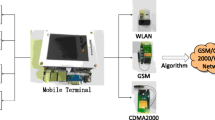Abstract
In order to solve the problem which fails to consider the degree of attribute dependence in current network access selection schemes, a novel heterogeneous network access selection scheme based on attribute dependence is proposed in this paper. The scheme translates the network access selection problem into the problem of multi-attribute decision making based on attribute dependence and solves it using the chaotic glowworm swarm based algorithm. First, the degree of attribute dependence is measured and the access selection model is established based on the degree of attribute dependence. Then, the chaotic glowworm swarm based algorithm is used to solve the optimal weight in the model. Finally, the user accesses the network with the best performance based on the access selection model. The simulation results demonstrate the improved performance of the proposed access selection scheme compared with other schemes. The proposed scheme can reduce blocking and handoff dropping rate, as well as the number of handoff. Moreover, the proposed scheme achieves the load balance of each network.











Similar content being viewed by others
References
Kellokoski, J., Koskinen, J., & Hämäläinen, T. (2014). Always best connected heterogeneous network concept. Wireless Personal Communications, 75(1), 63–80.
Kumar, A., Mallik, R. K., & Schober, R. (2014). A probabilistic approach to modeling users’ network selection in the presence of heterogeneous wireless networks. IEEE Transactions on Vehicular Technology, 63(7), 3331–3341.
Kunarak, S., & Suleesathira, R. (2010). Predictive RSS with fuzzy logic based vertical handoff algorithm in heterogeneous wireless networks. In 2010 International symposium on communications and information technologies (ISCIT) (pp. 1235–1240). IEEE.
Chang, B. J., et al. (2009). Markov decision process-based adaptive vertical handoff with RSS prediction in heterogeneous wireless networks. In Wireless communications and networking conference, 2009, WCNC 2009 (pp. 1–6). IEEE.
Zahran, A. H., Liang, B., & Saleh, A. (2006). Signal threshold adaptation for vertical handoff in heterogeneous wireless networks. Mobile Networks & Applications, 11(4), 625–640.
Zhu, G. X., Ning, G. Q., & Wang, H. Y. (2006). Research on sojourn-time-based dynamic load balancing algorithm in heterogeneous hierarchical wireless networks. Journal on Communications, 4, 29–36, 41.
Ahuja, K., Singh, B., & Khanna, R. (2014). Particle swarm optimization based network selection in heterogeneous wireless environment. Optik: International Journal for Light and Electron Optics, 125(1), 214–219.
Zhang, D., et al. (2013). An access selection algorithm based on GRA integrated with FAHP and entropy weight in hybrid wireless environment. In 2013 7th International conference on application of information and communication technologies (AICT) (pp. 1–5). IEEE.
Nguyen-Vuong, Q. T., et al. (1917). Multicriteria optimization of access selection to improve the quality of experience in heterogeneous wireless access networks. IEEE Transactions on Vehicular Technology, 47(1), 42–48.
Kosmides, P., Rouskas, A., & Anagnostou, M. (2014). Utility-based RAT selection optimization in heterogeneous wireless networks. Pervasive & Mobile Computing, 12(10), 92–111.
Kosmides, P., Rouskas, A., & Anagnostou, M. (2014). Utility-based RAT selection optimization in heterogeneous wireless networks. Pervasive and Mobile Computing, 12, 92–111.
Khawam, K., et al. (2010). Individual vs. global radio resource management in a hybrid broadband network. In 2011 IEEE international conference on communications (ICC) (pp. 1–6). IEEE.
Sang, A., et al. (2008). Coordinated load balancing, handoff/cell-site selection, and scheduling in multi-cell packet data systems. Wireless Networks, 14(1), 103–120.
Tang, L. R., et al. (2014). A chaos genetic algorithm based access selection in heterogeneous wireless networks. Acta Electronica Sinica, 42(8), 1564–1570.
Krishnanand, K. N., & Ghose, D. (2005). Detection of multiple source locations using a glowworm metaphor with applications to collective robotics. In Swarm intelligence symposium, 2005. SIS 2005. Proceedings 2005 IEEE (pp. 84–91).
Tang, L. R., Qi, Z., & Cui W. X. (2010). Synchronization scheme using four-dimensional chaotic system for OFDM. Journal on Communications, 1, 73–79, 84.
Yao, X., Liu, Y., & Lin, G. (1999). Evolutionary programming made faster. IEEE Transactions on Evolutionary Computation, 3(2), 82–102.
Acknowledgments
The work is supported by the 863 program No. 2014AA01A701, the Beijing Natural Science Foundation (4142049) and the Fundamental Research Funds for the Central Universities of China No. 2015XS07. Thanks are due to Shimo Du for assistance with the experiments and complexity analysis.
Author information
Authors and Affiliations
Corresponding author
Rights and permissions
About this article
Cite this article
Tang, L., Ji, S. & Yan, J. A Heterogeneous Network Access Selection Algorithm Based on Attribute Dependence. Wireless Pers Commun 92, 1163–1176 (2017). https://doi.org/10.1007/s11277-016-3600-6
Published:
Issue Date:
DOI: https://doi.org/10.1007/s11277-016-3600-6




